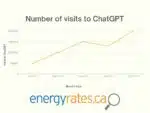
Looking at AI use, we don’t often think about how much electricity and energy gets used while AI processing – whether it’s image generation, word processing, and other applications online such as ChatGPT. Most people just think about using AI as a quick help tool or as a way to generate funny images, without thinking about the impact that it has on the environment or how much power it utilizes. AI technologies are rapidly advancing and evolving, not just in their capabilities, but also in their widespread use across business and personal sectors. Understanding and optimizing their energy usage is important and critical.
According to the International Energy Agency (IEA), who included the electricity consumption of data centers, cryptocurrency, and artificial intelligence for the first time ever in its projections for global energy use over the next two years – generative AI, bitcoin mining, and data centers themselves use an astounding amount of power in this digital age.
How much energy does AI use?
AI, especially generative AI, uses much more energy than most people would assume. The fastest-growing of these demands for energy is in the form of generative AI, which is a machine-learning artificial intelligence type. Training a large language model like OpenAI’s GPT-3, for example, uses nearly 1,300 megawatt-hours (MWh) of electricity, the annual consumption of about 130 US homes. The United States, China, and Europe are projected to remain the largest regions for data centre electricity demand over the coming years. Other regions, however, are currently experiencing strong growth in data centre developments, such as in Southeast Asia, where the electricity demand from data centres is expected to more than double by 2030.
According to the IEA, a single Google search takes 0.3 watt-hours of electricity, while a ChatGPT request takes 2.9 watt-hours. For reference, a single incandescent light bulb draws an average amount of 60 watt-hours of power.) If ChatGPT were integrated into the 9 billion searches done online each day, the IEA states that the electricity demand would increase by around 10 terawatt-hours a year – the amount estimated to be the power consumed by about 1.5 million EU residents. Which in comparison to Canada, would equal out to be most of our country in electricity usage.
Consumption increases by around 240 TWh (up 130%) in the United States, compared to the level it was in 2024. In China it increases by around 175 TWh (170%), Europe grows by more than 45 TWh (up to 70%), and Japan increases by around 15 TWh (80%) The importance of energy use per capita for data centre electricity is notable, as different parts of the same country can have varying energy usage – such as Africa having the lowest consumption at less than 1 kWh of data centre electricity consumption per capita, but South Africa shows strong growth and per-capita consumption more than 15 times larger than the continental average in 2030, with an intensity higher than 25 kWh per capita.
By contrast, the United States has the highest per-capita data centre consumption, sitting at around 540 kWh in 2024. This is projected to grow to over 1200 kWh per capita by the end of the decade, which is roughly as much as 10% of the annual electricity consumption of an average American household.
ChatGPT 4.0 is assumed to have been trained on its data by using around 25,000 GPUs, which are the most advanced and energy-intensive microprocessors available. The training itself would require a constant supply of about 20 megawatts of electricity for up to 100 days (or more). Roughly speaking, that is the same as the annual emissions from 193 average gasoline-powered cars or from 2000 barrels of oil. Once the AI is fully trained, depending on the model, they end up using nearly as much electricity generating responses for prompts – which is often called inference. Meta attributed approximately one-third of their internal end-to-end machine learning carbon footprint to model inference, with the remainder produced by data management, storage, and training.
A 2022 study from Google attributed 60% of its machine learning energy use to inference, compared to 40% for training. For perspective, generating a single AI image (say as a silly one you see online or being used by businesses for images) is estimated to need as much energy as fully charging a smartphone. Meanwhile, text generation is much lower in its energy consumption, but when it gets used a staggering amount – the numbers continue to add up. On average, roughly 1/4000th of a smartphone charge is required for a question and response.

It’s estimated that every time ChatGPT answers five to 50 connections, the chatbot uses up to 500mL of water – which doesn’t seem like a lot at one, but when you estimate how many queries are asked of it, the number becomes astronomical. Millions of users asking multiple questions daily add up fast. In Microsoft’s environmental report, global water consumption grew 34% from 2021 to 2022 to nearly 6.4 gigaliters (GL), a sharp increase compared to previous years. That much water could fill more than 2,500 Olympic-sized swimming pools. Similarly, Google reports a 20% growth in water usage in the same period.
Why is energy consumption going up so fast?
The entire world’s demand for electricity and energy use is only increasing and the reason it’s going up so fast with consumption being the highest it has ever been in years is that it’s driven by robust economic growth, intense heatwaves, and increasing uptakes of using technologies that use their own immense amounts of power, such as AI and bitcoin mining. Air conditioning and heat pumps also included in the mix for what taxes the electricity grid. In Canada, there were several provinces that had to warn about ‘brownouts’ to take some stress off the grid when the summer heat was at record-breaking temperatures and more people had to rely on their air conditioners and fans, not including the businesses as well.
Our current global use of electricity is only going to go up and with environmental problems that may be rising exponentially due to major uses, such as generative AI and other programs being used constantly when it isn’t necessary to use, but uses more electricity than you’d expect from being simple programs we use online without a second thought. Asking ChatGPT a question, help write an essay, helping fix a coding issue or generating silly AI-generated images are the reasons that energy consumption is rising.
Could AI help us save on energy?
AI programs can be trained on specific tasks or on multiple different ones. The range of tasks that a model can solve and its task diversity has an impact on its energy consumption as well. While diverse models appear to be more effective in terms of their overall training footprint, in the inference stage the range of their ability takes on average more energy than those of any task-specific models. That all being said – AI could be trained to help save on energy, and it already does with smart thermostats and other uses such as modelling buildings to predict further energy use and optimizing current heating and cooling to improve the efficiency of manufacturing and more with predictive maintenance.
Not all AI is generative AI that uses a ton of electricity and imprints a large carbon footprint. Many smart devices help to improve our carbon footprints and save energy by being utilized either from the beginning or by helping already-built buildings/businesses. Essentially AI could help save on energy down the line, as long as it is implemented well, used correctly, and isn’t leaving a large carbon footprint that negates its purpose.
Artificial intelligence does offer the potential for solutions to some of the problems we currently are seeing, and is currently doing so as it is being applied to better predict electricity demand and renewables output, automatically manages demands to match supplies better, and it can better monitor infrastructure for faults and it can help predict maintenance needs before problems arise. Applications are also of course not limited to just the electricity section, as the combination of AI and robotics could lead to a much more efficient and precise production process, potentially lowering the costs, such as lower costs with battery manufacturing or PV.
There are also other substantial AI applications for the oil and gas production areas, including analysis for subsurface data and optimising the operations of refineries or drilling rigs. Assets and infrastructures such as these operate in challenging and changing environments, which can highly benefit from AI use, helping to keep things operating more efficiently and down the line save energy and money.
Could AI lead to an energy crisis?
With AI becoming more and more prevalent within our everyday lives, you see it on apps and businesses using ChatGPT as a search engine or generating images for fun on your phone, using them for business purposes, with everything being pushed towards AI helpers such as on smartphones or video effects for editing – the list can go on infinitely for what AI has been included in and encouraged for use.
The amount of energy and power required by AI just to do basic tasks is very high, combined with how much it is already being used, on top of the predicted numbers for its use only going up as the next few years continue on, it isn’t out of the question that AI use could trigger a global energy crisis down the line if the current electric grids and AI usage policies don’t meet the demands or if the systems and grids don’t get upgraded to meet the future demands that are only steadily rising as the years go on in this digital age.
Does AI use more electricity than Bitcoin mining?
According to Reuters, currently, data centers account for about 1-1.3% of global electricity consumption, versus crypto mining, which is roughly at 0.4%. The disparity is expected to grow as time goes on. AI use and bitcoin mining both make up for a huge amount of electricity used – keep in mind, that 1.3% seems like a miniscule number, but it is global, for the entire world.
Analysts expect 20% of Bitcoin miner power capacity to pivot to AI by the end of 2027, which is not far away at the time of writing this article. To explain just how much power bitcoin mining uses – the New York Times equated the total power consumed by Bitcoin annually is what Finland uses in one year. Even the most efficient bitcoin mining operation takes roughly 155,000 kWh to mine a single bitcoin, which in comparison – the average household consumes about 900 kWh per month.
The rate of both AI and bitcoin mining is similar, with AI getting pushed into every project though, it’s likely that it will continue to soar upwards as it gets used by millions of people multiple times a day, and with more businesses shoving it into everything from Adobe to help write essays, it will continue to use more water and resources. Only time will tell which will use more energy.
Can AI optimize energy use and accelerate innovation?
Another side of the coin is that AI use can accelerate innovation in areas such as healthcare and technology developments, and also including different ways, such as battery chemistries, is already underway and possible. Many of the technologies required for clean energy transitions are already commercially available and are increasingly cost-competitive. Meeting countries’ goals for achieving net-zero emissions will of course require clean energy technologies all around while continuously improving the ones that are available on the market.
With AI being applied to accelerate innovation and technology developments, including the energu sector itself, understanding how much AI can accelerate energy innovations while it works on a way to lessen its footprint is highly important – especially with how much it is being used and will continue to be used by corporations now and much more in the years to come. It will require further analysis and collaboration between industries and government to find the proper spot in understanding how AI can work with the energy sector and with other areas while also lessening the problems that it comes with.
How AI data centers can save on energy
In such an energy-intensive industry, securing a cost-effective energy plan is essential for the growth of your operations. If you’re looking for electricity and natural gas options for your large commercial or industrial facility, EnergyRates.ca has got you covered. We are Canada’s leading energy rate comparison website, and our commercial energy team is prepared to guide you along the way and provide you with multiple energy plans, custom quotes, and contract reviews so you can make a business-wise decision regarding your energy costs.
To learn more, fill out your postal code in the form above or contact us here.











